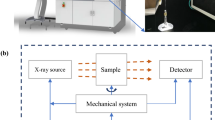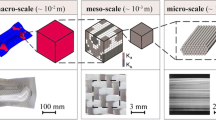Abstract
Understanding the pore structure of paper and its permeability behavior is important for designing paper-based materials. In this study, the three-dimensional structure of paper was investigated using X-ray computed tomography, and the representative elementary volume (REV) was determined to be 400 × 400 × 450 pixels by the porosity criterion. The pore structural parameters of the REV were experimentally validated. Permeability simulations were carried out in the thickness direction (perpendicular to the paper plane, denoted as the Z direction), horizontal direction (any direction of the paper plane, denoted as the X–Y plane), double outlet, and triple outlet conditions. The simulated permeability in the thickness direction (1.69 µm2) was very close to the experimental value (1.88 µm2). The calculated permeability in the horizontal direction (8.38 µm2) was much greater than that in the thickness direction, revealing that the paper had a high pore connectivity and large pore size in the horizontal direction, giving it a high permeability. Compared with the single outlet case, in the case of the double and triple outlet boundary conditions, more fluid flowed out from the side outlets, and the internal pressure declined faster. This study provides an approach for the structural design and performance optimization of paper-based materials.
















Similar content being viewed by others
Data availability
Not applicable.
References
Aslannejad H, Hassanizadeh SM, Raoof A, de Winter DAM, Tomozeiu N, Van Genuchten MT (2017) Characterizing the hydraulic properties of paper coating layer using FIB-SEM tomography and 3D pore-scale modeling. Chem Eng Sci 160:275–280. https://doi.org/10.1016/j.ces.2016.11.021
Axelsson M, Svensson S (2010) 3d pore structure characterisation of paper. Pattern Anal Appl 13(2):159–172. https://doi.org/10.1007/s10044-009-0146-1
Buadez A, Coll B, Morel JM (2005) A non-local algorithm for image denoising. In: 2005 IEEE computer society conference on computer vision and pattern recognition (CVPR’05), vol 2, pp 60–65
Chang S, Seo J, Hong S, Lee DG, Kim W (2018) Dynamics of liquid imbibition through paper with intra-fibre pores. J Fluid Mech 845:36–50. https://doi.org/10.1017/jfm.2018.235
Dalcin L, Rojas D, Zampini S, Fernández DCDR, Carpenter MH, Parsani M (2019) Conservative and entropy stable solid wall boundary conditions for the compressible Navier–Stokes equations: adiabatic wall and heat entropy transfer. J Comput Phys 397:108775. https://doi.org/10.1016/j.jcp.2019.06.051
Denton RE, Hu Y (2009) Symmetry boundary conditions. J Comput Phys 228(13):4823–4835. https://doi.org/10.1016/j.jcp.2009.03.033
Fan N, Wang J, Deng C, Fan Y, Wang T, Guo X (2020) Quantitative characterization of coal microstructure and visualization seepage of macropores using CT-based 3D reconstruction. J Nat Gas Sci Eng 81:103384. https://doi.org/10.1016/j.jngse.2020.103384
Feng Y, Guo S, Jacob J, Sagaut P (2019) Solid wall and open boundary conditions in hybrid recursive regularized lattice boltzmann method for compressible flows. Phys Fluids 31(12):126103. https://doi.org/10.1063/1.5129138
Ismail MY, Patanen M, Kauppinen S, Kosonen H, Ristolainen M, Hall SA, Liimatainen H (2020) Surface analysis of tissue paper using laser scanning confocal microscopy and micro-computed topography. Cellulose 27(15):8989–9003. https://doi.org/10.1007/s10570-020-03399-w
Jackson GW, James DF (1986) The permeability of fibrous porous media. Can J Chem Eng 64(3):364–374. https://doi.org/10.1002/cjce.5450640302
Jaganathan S, Tafreshi HV, Pourdeyhimi B (2008) A realistic approach for modeling permeability of fibrous media: 3-D imaging coupled with CFD simulation. Chem Eng Sci 63(1):244–252. https://doi.org/10.1016/j.ces.2007.09.020
Jiang S, Xi J, Dai H, Wu W, Xiao H (2022) Multifunctional cellulose paper-based materials and their application in complex wastewater treatment. Int J Biol Macromol 207:414–423. https://doi.org/10.1016/j.ijbiomac.2022.03.017
Krasnoshlyk V, Rolland du Roscoat S, Dumont PJJ, Isaksson P, Ando E, Bonnin A (2018) Three-dimensional visualization and quantification of the fracture mechanisms in sparse fibre networks using multiscale X-ray microtomography. P Roy Soc A-Math Phy 474(2215):20180175. https://doi.org/10.1098/rspa.2018.0175
Lavrykov S, Singh SK, Ramarao BV, Ramaswamy S (2016) Pande H analysis of the permeability tensor and the correlation length of heterogeneities in paper using X-ray microtomography. Dry Technol 34(8):871–882. https://doi.org/10.1080/07373937.2015.1057837
Li Y, Chi Y, Zhao C, Miao Y, Han S, Chen L (2022) Modelling fluid flow in carbon fibre porous media based on X-ray microtomography and lattice boltzmann method. Compos Struct 300:116085. https://doi.org/10.1016/j.compstruct.2022.116085
McIntosh NJ, Sharma Y, Martinez DM, Olson JA, Phillion AB (2019) Estimating the transverse dimensions of cellulose fibres in wood and paper using 2D and 3D microscopy techniques. Cellulose 26(3):2099–2108. https://doi.org/10.1007/s10570-018-02231-w
Mendes ADO, Fiadeiro PT, Costa AP, Amaral ME, Belgacem MN (2015) Laser scanning for assessment of the fiber anisotropy and orientation in the surfaces and bulk of the paper. Nord Pulp Pap Res J 30(2):308–318. https://doi.org/10.3183/npprj-2015-30-02-p308-318
Monteleone A, Monteforte M, Napoli E (2017) Inflow/outflow pressure boundary conditions for smoothed particle hydrodynamics simulations of incompressible flows. Comput Fluids 159:9–22. https://doi.org/10.1016/j.compfluid.2017.09.011
Ni X, Miao J, Lv R, Lin X (2017) Quantitative 3D spatial characterization and flow simulation of coal macropores based on µCT technology. Fuel 200:199–207. https://doi.org/10.1016/j.fuel.2017.03.068
Nilsson L, Stenström S (1997) A study of the permeability of pulp and paper. Int J Multiphas Flow 23(1):131–153. https://doi.org/10.1016/S0301-9322(96)00064-X
Otsu N (1979) A threshold selection method from Gray-Level Histogram. IEEE Trans Syst Man Cybernet 9(1):62–66
Pan Z, Zhang X, Sun Z, Jiang F, Lin L, Liang Y, Wang J et al (2021) High fidelity simulation of ultrafine PM filtration by multiscale fibrous media characterized by a combination of X-ray CT and FIB-SEM. J Membrane Sci 620:118925. https://doi.org/10.1016/j.memsci.2020.118925
Pradhan AK, Das D, Chattopadhyay R, Singh SN (2012) Effect of 3D fiber orientation distribution on transverse air permeability of fibrous porous media. Powder Technol 221:101–104. https://doi.org/10.1016/j.powtec.2011.12.027
Reichenbach M, Seidler R, Pfundt B, Fey D (2014) Fast image processing for optical metrology utilizing heterogeneous computer architectures. Comput Electr Eng 40(4):1158–1170. https://doi.org/10.1016/j.compeleceng.2013.09.008
Ryabko B, Rakitskiy A (2020) Application of the computer capacity to the analysis of processors Evolution. J Circuit Syst Comp 29(08):2050127. https://doi.org/10.1142/S0218126620501273
Shirazi M, Esmail N, Garnier G, Van de Ven TGM (2005) Starch penetration into paper in a size press. J Disper Sci Technol 25(4):457–468. https://doi.org/10.1081/DIS-200025714
Simaafrookhteh S, Shakeri M, Baniassadi M, Sahraei AA (2018) Microstructure reconstruction and characterization of the porous GDLs for PEMFC based on fibers orientation distribution. Fuel Cells 18:160–172. https://doi.org/10.1002/fuce.201700239
Sobieski W (2019) Numerical investigations of tortuosity in randomly generated pore structures. Math Comput Simul 166:1–20. https://doi.org/10.1016/j.matcom.2019.04.005
Soltani P, Johari MS, Zarrebini M (2014) Effect of 3D fiber orientation on permeability of realistic fibrous porous networks. Powder Technol 254:44–56. https://doi.org/10.1016/j.powtec.2014.01.001
Spalding DB (1961) Mass transfer through laminar boundary layers—1. The velocity boundary layer. Int J Heat Mass Tran 2(1–2):15–32. https://doi.org/10.1016/0017-9310(61)90012-6
Straube C, Meyer J, Dittler A (2021) Identification of deposited oil structures on thin porous oil mist filter media applying µ-CT imaging technique. Separations 8(10):193. https://doi.org/10.3390/separations8100193
Wang J, Jiang F, Zhang C, Song Z, Mo W (2021) Study on the pore structure and fractal dimension of tight sandstone in coal measures. Energy Fuels 35(5):3887–3898. https://doi.org/10.1021/acs.energyfuels.0c03991
Xu J, Liu Y, Li J, Shen W, Corriou JP (2022) Statistical Reconstruction of 3D paper structure using simulated annealing algorithm based on 2D scanning electron microscopy image. J Nat Fibers 19(16):13815–13830. https://doi.org/10.1080/15440478.2022.2107141
Xu Y, Xu L, Qiu S, Jiang Z, Rao B, Xu P (2022) A study on the through-plane permeability of Anisotropic Fibrous Porous Material by Fractal Stochastic Method. Materials 15(22):8064. https://doi.org/10.3390/ma15228064
Zhang L, Zhou L, Ren L, Laili Y (2019) Modeling and simulation in intelligent manufacturing. Comput Ind 112:103123. https://doi.org/10.1016/j.compind.2019.08.004
Zhou M, Fang M, Quan Z, Zhang H, Qin X, Wang R, Yu J (2019) Large-scale preparation of micro-gradient structured sub-micro fibrous membranes with narrow diameter distributions for high-efficiency air purification. Environ Sci-Nano 6:3560–3578. https://doi.org/10.1016/j.seppur.2021.119258
Acknowledgments
The authors are thankful for the research assistance provided by Qilu University of Technology, Jinan, P. R. China.
Funding
The authors appreciate the supports provided by National Key Research and Development Program of China (2022YFF0607201), National Natural Science Foundation of Guangdong Province, China (2023A1515011422), Project to Attract Foreign Experts by MOST (G2022163012L), and Science and Technology Program of Guangzhou, China (202201010481).
Author information
Authors and Affiliations
Contributions
Yi Wang: Investigation, Data curation, Writing-original draft. Yin Liu: Investigation, Writing-review. Jiaxian Chen: Writing-review. Jie Xu: Investigation, Resources. Wenhao Shen: Validation, Supervision, Conceptualization, Writing-review and editing. Jean-Pierre Corriou: Methodology, Writing-review.
Corresponding author
Ethics declarations
Competing interests
The authors declare no competing interests.
Ethics approval and consent to participate
The article does not include human participants and/or animals research.
Consent for publication
All authors gave their consent for publication.
Additional information
Publisher’s Note
Springer Nature remains neutral with regard to jurisdictional claims in published maps and institutional affiliations.
Electronic supplementary material
Below is the link to the electronic supplementary material.
Rights and permissions
Springer Nature or its licensor (e.g. a society or other partner) holds exclusive rights to this article under a publishing agreement with the author(s) or other rightsholder(s); author self-archiving of the accepted manuscript version of this article is solely governed by the terms of such publishing agreement and applicable law.
About this article
Cite this article
Wang, Y., Liu, Y., Chen, J. et al. Multidirectional permeability simulation for fiber network based on the pore structure 3D characterization by CT scanning. Cellulose 31, 187–203 (2024). https://doi.org/10.1007/s10570-023-05645-3
Received:
Accepted:
Published:
Issue Date:
DOI: https://doi.org/10.1007/s10570-023-05645-3




